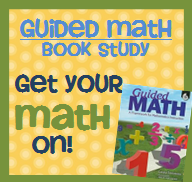I am still getting caught up on the Guided Math Book Study. I think this chapter has been one of my favorite because I will be conferring with my students this coming school year and I think this chapter really gave me a wealth of information to help me set up the structure and record keeping of these conferences. My to-do list for Guided Math is growing like the weeds in my landscaping. :)
Thanks to Mrs. Patton's Patch and Thinking of Teaching for hosting Chapter 7. Check out the links for several different posts on this chapter. You may find a freebie or two from some of the teachers who have linked up. I took LOTS of notes on this chapter and decided to just share just two of the main points, the structure of a conference and keeping records of conferences. Do you conference with your math students? Any great tips to share?
The Structure of a Conference
Research Student Understanding:
Decide What is Needed:
Teach to Student Needs:
Link to the future:
“Conferring With Students During Guided Math”
The Structure of a Conference
Research Student Understanding:
- Observe the work of the student and interview him or her to understand what he or she is trying to do as a mathematician. Probe to glean more about the students’ intentions.
- Name specifically what the student has done as a mathematician, linking it directly to the language of the standards and remind him or her to do this in future work.
Decide What is Needed:
- Weigh whether you want to accept or alter the student’s current strategies and process. Decide what you want to teach and how you will teach it.
Teach to Student Needs:
- Use demonstration, guided practice, or explicit telling and showing to correct or extend a student’s understanding and ability to successfully complete the task.
Link to the future:
- Name what the student has done as a mathematician and remind him or her to do this often in the future.
Keeping Records of Conferences
What teachers learn as they confer with students can be as valuable as what their students learn. Teachers can use this data to tailor their instruction in the other components of the Guided Math framework. To do this effectively, teachers must have some method of recording what they learn and then use it. What is most important is that the notes are not filed and forgotten.
When used wisely, these valuable notes can guide instruction, they can help teachers:
What teachers learn as they confer with students can be as valuable as what their students learn. Teachers can use this data to tailor their instruction in the other components of the Guided Math framework. To do this effectively, teachers must have some method of recording what they learn and then use it. What is most important is that the notes are not filed and forgotten.
When used wisely, these valuable notes can guide instruction, they can help teachers:
- Plan for future conferences-If teachers note that many students are struggling with the same concept in a unit, they may want to confer with other students to see if they are also struggling. Or, if students seem well beyond where a teacher thought they would be, it may be worthwhile to confer with additional students to see if perhaps instruction could move ahead a little more quickly than planned originally.
- Recognize the strengths of their students-When teachers identify students who have mastered the standards being taught, they can modify the instruction for these students and allow them to move on.
- Discover future teaching options-Conference conversations suggest lessons from which students can benefit that may not be possible to address in that conference. The lessons may be ones which would benefit the whole class or a small group of students.
- Broaden the scope of conferences-As teachers review their conference notes, they may decide to confer with students based on previously noted concerns.
- Follow-up on conference teaching points-Teachers who have records of their conference teaching points with their students can follow-up on these in subsequent conferences to confirm student understanding.
Review and Reflect
- In what ways are you able to discover your students' mathematical thinking? I can do this by observing their written work. I also am able to do this by having them verbally share their thinking or problem solving strategies. I can observe them working out a problem and question them on their thought process.
- How frequently are you able to confer with your students? If you are not able to confer as often as you would like, what prevents it? I have previously not formally conferred with my students. I have done some informal conferring with them, but nothing like what is expected in this chapter. This coming year I will definitely be conferring with students. This will be a very big component of our personalized learning model. The plan will be to confer with students on the days when the other students are working on MATHia software. This should helps to keep other students on task while I am conferring with students.
- What advantages are there to having structures for conferences in mind as you meet with your students? Having a structure will make the conferring time much more purposeful. The information I gather will be much more meaningful to drive my instruction for that individual student as well as the class as a whole. Taking good notes on the conferences will insure that I use the information for future planning.


No comments:
Post a Comment
Thank you so much for visiting my blog and leaving a comment. Feel free to email me at luvbcd@yahoo.com with any questions you have.